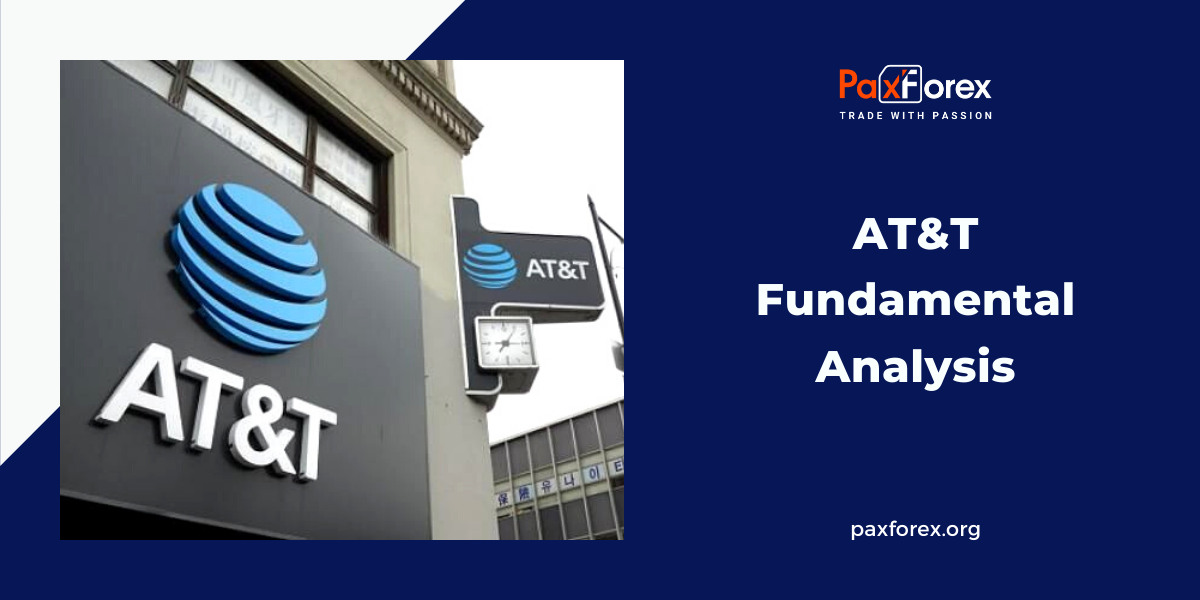
Source: PaxForex Premium Analytics Portal, Fundamental Insight
Under previous CEO Randall Stephenson, AT&T took on huge debt to build an entertainment empire. But the high costs of rolling out a 5G network and the aggressive character of the U.S. telecommunications market have prompted current CEO John Stankey, who is only in his first year in the job, to back away from his predecessor's decisions.
AT&T's stock price fell after it said that its WarnerMedia unit would merge with Discovery to form a new entertainment company, a deal that would affect AT&T's high-yield dividend. The stock price never recovered from hitting a 52-week high of $33.88 in May shortly prior to the news. But now that AT&T is returning its full attention to its core telecom business, the company has reason to be optimistic. AT&T posted strong revenues of $88 billion in the first half of 2021, up from $83.7 billion in 2020, thanks to its strong position in the telecommunications
business. The mobility segment, the company's largest revenue-generating unit (made up of wireless and equipment services revenue), posted a 10.4% year-over-year increase in revenue in Q2. The double-digit year-over-year performance is quite expected, given the impact of the coronavirus pandemic in 2020.
More impressive, however, is that second-quarter mobility segment revenue of $18.9 billion exceeded the 2019 figure of $17.3 billion before the pandemic. Mobility segment revenue has been growing steadily for several quarters after the pandemic contributed to last year's second-quarter numbers. Strong subscriber growth contributed to AT&T's service revenue growth. The company's net subscriber growth among postpaid subscribers, the telecom industry's most valuable customer segment, was 1.2 million in the second quarter, a sharp change from last year's loss of 154,000. Net growth in postpaid subscribers last year was the best in a decade.
This growth in subscribers was bolstered by a record low postpaid subscriber churn rate of 0.69%. Customer retention is just as important as acquiring new
customers, and AT&T excels at both. AT&T's telecom performance is complemented by an increase in its HBO Max streaming service, a key segment of WarnerMedia's entertainment division. The service was launched last May and has been steadily increasing the number of subscribers each quarter. HBO Max is among the top five streaming services that U.S. households subscribe to. Accordingly, AT&T's direct sales revenue, which includes HBO Max, rose to $2.1 billion in the second quarter from $1.6 billion last year. Although HBO Max is part of the WarnerMedia merger with Discovery, shareholders will receive stock in the new company, Warner Bros. Discovery, after the deal closes next year. While investors were not happy to learn that the WarnerMedia deal includes a change in AT&T's high-yield dividend, that is not the only element affecting AT&T's stock price.
Another factor is the company's huge amount of debt. At the end of the second quarter, the company's total debt was nearly $180 billion. Some of that debt will go to the new company along with WarnerMedia. As a result, AT&T expects its net debt to adjusted the EBITDA ratio to be less than 2.5 by the end of 2023, up from 3.2 at the end of the second quarter. Before the WarnerMedia deal, AT&T may have been an attractive investment mainly because of its impressive dividend, but it will remain attractive for several other reasons after the deal is completed. Under Stankey's leadership, the company's core telecommunications business is showing strength not seen in years. AT&T is also in the early stages of transitioning to its 5G network, which presents the telecom company with profit opportunities for years to come.
The business has already altered its forecast for 2021, raising revenue growth from 1% to 2-3%. HBO Max is performing well, and WarnerMedia's merger with Discovery will help HBO Max proceed to develop by stimulating the extension of its global presence. Today, HBO is a predominantly U.S. offering, with only 20.5 million of its 67.5 million subscribers representing international markets. That gives a lot of room for international expansion in the coming years. Investors can take advantage of AT&T's high-yield dividends now. After the WarnerMedia deal closes, they will own shares in both a telecommunications company showing strong growth and a booming entertainment company. After the deal, AT&T will remain a good return bet, but with a strong telecom business and plenty of free cash flow available to invest in the company's 5G future. These factors make it a worthy investment in the eyes of investors.

As long as the price is above the 26.90 level, follow the recommendations below:
- Time frame: D1
- Recommendation: long position
- Entry point: 27.43
- Take Profit 1: 28.70
- Take Profit 2: 29.30
Alternative scenario:
If the level of 26.90 is broken-down, follow the recommendations below:
- Time frame: D1
- Recommendation: short position
- Entry point: 26.90
- Take Profit 1: 26.40
- Take Profit 2: 26.10













